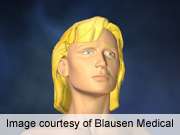For patients who undergo midface rejuvenation surgery, the rate of dissatisfaction with outcome is associated with malar hypoplasia and loss of elasticity, according to a study published online Jan. 24 in JAMA Facial Plastic Surgery.
(HealthDay)—For patients who undergo midface rejuvenation surgery, the rate of dissatisfaction with outcome is associated with malar hypoplasia and loss of elasticity, according to a study published online Jan. 24 in JAMA Facial Plastic Surgery.
Andrew A. Jacono, M.D., and Evan R. Ransom, M.D., from the North Shore University Hospital in Manhasset, N.Y., conducted a retrospective review of 150 patients (mean age, 51 years; 93.3 percent women) who underwent surgical midface rejuvenation by a single surgeon. Demographics, history, procedures, outcomes, and complications were recorded. Preoperative midface anatomy and aging were assessed using a classification system assigning ascending numbered grades (classes I, II, and III) to indicate increasing severity of midfacial aging and lettered grades to represent normal (A) or abnormal (B) skeletal anatomy. Patient satisfaction at 12 months was used to determine outcome; unsatisfactory results were further reviewed by a blinded independent expert.
The researchers found that multimodality treatment was used in 34 percent of cases. In 14 percent of cases there was patient dissatisfaction, and the expert concurred in all cases. The greatest propensity for dissatisfaction was noted in procedures involving autologous fat grafting alone (four of 12 cases; 33 percent). The rate of dissatisfaction was not associated with age, but was significantly higher with malar hypoplasia (41 percent in class B versus 7 percent in class A) and loss of elasticity (16 percent in class IIIA versus 3 percent in classes IA and IIA).
"Dissatisfaction is most common in cases where midfacial aging is accompanied by skeletal insufficiency or severe loss of elasticity," the authors write. "Having the right discussion with the patient and choosing the best rejuvenation plan will help maximize patient satisfaction."
More information:
Abstract
Full Text (subscription or payment may be required)
Health News Copyright © 2013 HealthDay. All rights reserved.




















